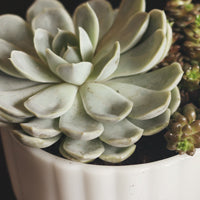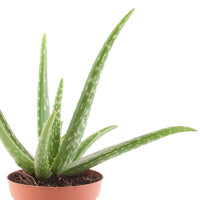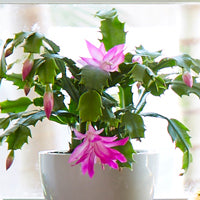By Karen Weir-Jimerson
Do you have a plant that you need help identifying? Specific characteristics, such as the leaf shape, texture, or color, can help you figure out what the plant is.
Touch the leaf!Is it thick and sort of springy to the touch? This is often described as feeling “fleshy”. There are fleshy leaves that are both smooth and furry. Botanical Latin tells us that the word “succulent” means “very cellular and juicy.” That’s because many species of succulents have leaves and stems with a “sappy, juicy” interior. For example, Aloe, which is a succulent, has thick fleshy leaves whose juicy interior is used as a skin salve.
Which types of plants produce fleshy leaves? There are many plants with thick, fleshy leaves. Most are in the succulent family, but not all are.The leaves of succulents hold moisture, which is also why most plants with fleshy leaves also need less water. When plants with fleshy leaves are under watered, you may see their leaves become less thick or shriveled, because they are using their moisture reserves to hydrate themselves.
Here are 11 popular houseplants with fleshy leaves:

1. Kalanchoe
Kalanchoe is prized for its thick leaves as well as its bright flowers. Some kalanchoe leaves are wide, smooth and flat, like Kalanchoe thyrsiflora, also known as Flapjack. Others are fleshy, such as Kalanchoe fedtschenkoi 'Variegata' (in photo) and furry, such as Kalanchoe tomentosa, as called Panda plant because of its fuzzy exterior. See kalanchoe varieties here.

2. Jade plant (Crassula ovata)
Jade plant (in photo) is a member of the fleshy-leaved Crassula family. Jade plant grows a tree-like trunk with thick, fleshy dark green leaves. Other types of Crassulas also offer fleshy leaves but look very different from Jade plants. For example calico kitten (Crassula marginata 'Variegata') is a low-growing colorful crassula and Crassula tetragona looks like a little pine tree. See crassula varieties here.

3. Echeveria
If you don’t know a thing about succulents, you surely know echeveria, even though you might have never heard the word. The rosette like swirls of fleshy leaves are what makes echeveria everyone’s favorite succulent. This plant comes in many colors, but the blue echeveria is the darling of succulent bowls everywhere. Here are all the echeveria varieties; be prepared to fall in love.

4. Aloe
Known in the world of natural medicine as salve to calm burns or rashes, the fleshy leaves of Aloe vera, (in photo) when cut, bleed a soothing salve. (Note: before using plants in a medicinal way, make sure to consult your doctor.) Aloe comes in a lot of other fleshy versions too, all which look beautiful in dish gardens. See them all here.

5. Haworthia
These South African natives are related to aloe and gasteria. They form cute little rosettes and can grow singly or in clumps. Small and slow growing, haworthia are often called zebra cactus because of their cool stripes. Their leaves are more dense (and not as squishy) as other fleshy-leaved plants. See more Haworthia varieties here.

6. Senecio
There are many types of senecios, all which have fleshy leaves. Himalayan Senecio (Senecio talinoides), in photo, grows upright like a little tree and has needle-like green leaves. Senecio radicans goes by the name String of Bananas because its trailing stems feature fleshy, banana-shape leaves. And Senecio rowleyanus Is called String of Beads because it features round, bead-like leaves on trailing stems. See the diverse group of senecios here.

7. Sedum
Sedum are fleshy-leaf plants that are most commonly grown outdoors, although you may see them in succulent dishes on occasion. Available in an endless selection of sizes, colors, and shapes, sedum vary from 3-inch-tall ground huggers to 3-foot-tall beauties. They are ideal for the landscape, making beautiful ground cover and container plants. Sedum needs 6 to 8 hours of sunlight. See the range of sedum possibilities here.

8. Portulacaria
There are several types of portulacaria. Portulacaria afra, called elephant bush or baby jade, (in photo) is a shrubby plant with dark green leaves and red-flushed stems. It is tender, growing in Zone 10 outdoors. Portulacaria afra 'Variegata', or variegated baby jade plant, offers red-purple stems and small round white-variegated leaves. It also grows outdoors only in Zone 10. See more about portulacaria here.

9. Holiday Cactus (Schlumbergera)
Holiday Cactus has slightly fleshy leaves. But this plant is most beloved for its colorful flowers. This easy-care grower bursts into bloom during the winter holiday season, flowering in a wide variety of colors, including pink, red, scarlet, orange, gold, cream, and white -- as well as bicolors. Read more about Christmas cactus here.

10. Gasteria
This is another tender outdoor plant (most grow outdoors only in Zone 10) that may find its way indoors. Gasteria bicolor var. Liliputana (in photo) is a diminutive variety that shows off small, dark green leaves spotted in light green. Gasteria brevifolia (also called ox tongue) has rough, textured, dark green leaves variegated with white spots. See them both here.

11. Graptosedum
This fleshly plant offers thick leaves in a rosette like formation. Some look like chubbier versions of Escheveria. These little succulents come a variety colors, including pastel green, purple, white, peach, and orange. Like all succulents, they like life on the dry side.

















